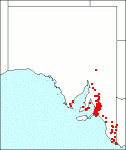Family: Boraginaceae
Cynoglossum suaveolens
Citation:
R. Br., Prod. Fl. Nov. Holl. 495 (1810).
Synonymy: Not Applicable Common name: Sweet hounds tongue, sweet forget-me-not.
Description:
Perennials to 40 cm high, with one to few erect stems from the basal rosette, with a tap root, covered with spreading to appressed hairs being usually a mixture of short fine ones and longer ones with a broad base; leaves densely clustered, oblanceolate, subpetiolate but with a broadened sheath in the basal rosette becoming widely spaced, lanceolate and sessile below the inflorescence, 2-15 x 0.7-1.8 cm, pointed, often with undulate margins.
Inflorescence terminal, with 1 to a few monochasia being once or twice dichotomously branched, with pedicellate flowers subtended by often leaf-like bracts; sepals connate to half their length, 2-3 mm long or to 4 mm when fruiting, with lobes triangular, bluntly acute to rounded, covered with forward-directed appressed hairs; corolla funnel-shaped, blue, glabrous except for papillose 2-lobed saccate protrusions in the throat, 4-4.5 mm long; lobes broadly oblong-ovate, c. 2 mm long, with a rounded apex; stamens inserted just above the middle of the corolla tube, with anthers almost sessile, narrowly ovoid to ellipsoid, c. 1 mm long, constricted towards the apex but without an appendage; ovary 4-lobed, with the c. 1.5 mm long style inserted near the base, slightly broadened towards the base and with a capitate terminal stigma.
Mericarps almost globular and without a winged rim, densely covered on the upper surface with coarse spines with barbed apices, pale-brown.

| Flowering branch, extreme variation of mericarps in two views.
|
Image source: fig. 534B in Jessop J.P. & Toelken H.R. (Ed.) 1986. Flora of South Australia (4th edn).
|
Published illustration:
Cochrane et al. (1968) Flowers and plants of Victoria, fig. 230; Cunningham et al. (1982) Plants of western New South Wales, p. 565.
|
|
Distribution:
|
Qld; N.S.W; Vic.; Tas.
|
Conservation status:
native
Flowering time: Sept. — Jan.
|

SA Distribution Map based
on current data relating to
specimens held in the
State Herbarium of South Australia
|
Biology:
It is remarkable how few flowers of this species on South Australian specimens set fruit and yet it does not seem to be a rare plant. This is even more remarkable when one compares it with the prolific C australe.
Author:
Not yet available
|

